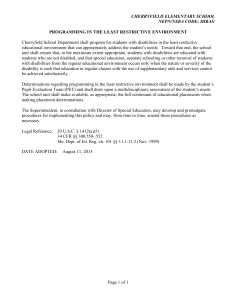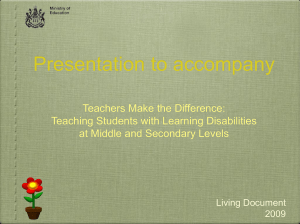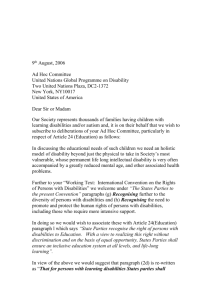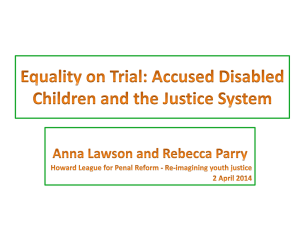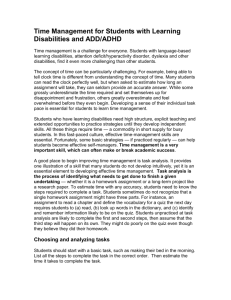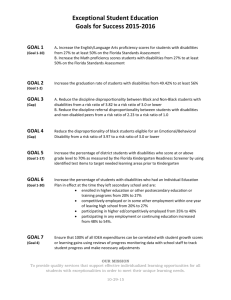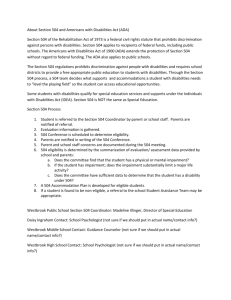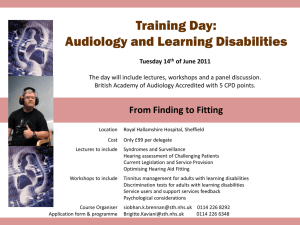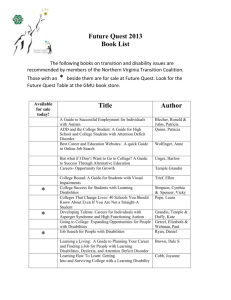School Transportation and Students with Significant Disabilities
advertisement
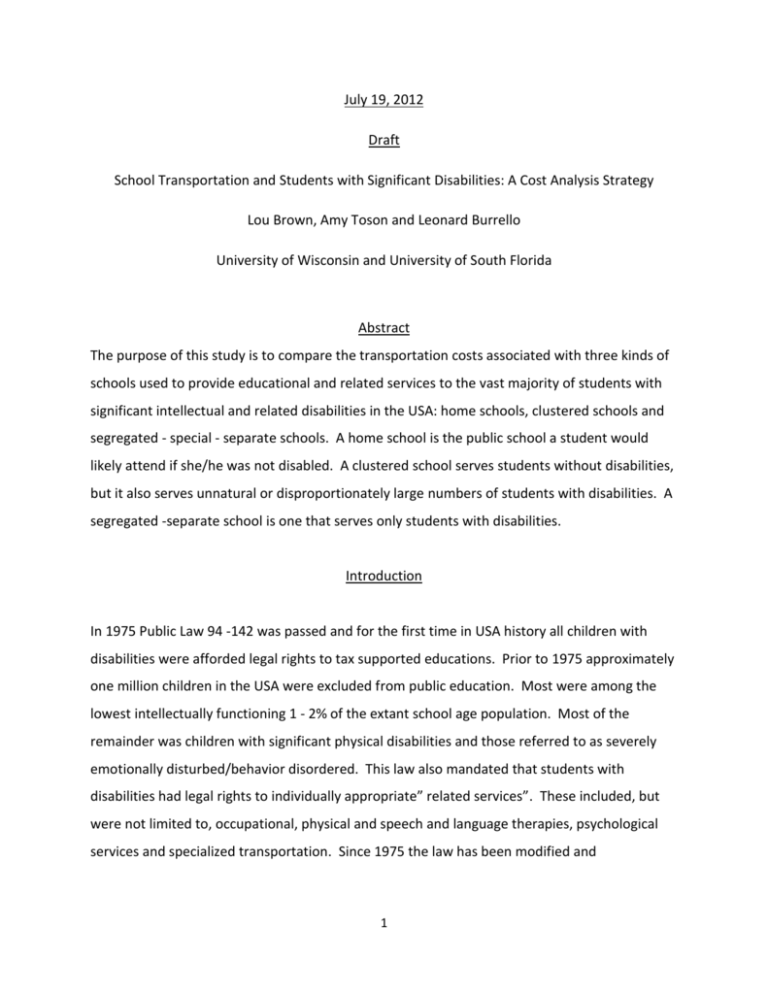
July 19, 2012 Draft School Transportation and Students with Significant Disabilities: A Cost Analysis Strategy Lou Brown, Amy Toson and Leonard Burrello University of Wisconsin and University of South Florida Abstract The purpose of this study is to compare the transportation costs associated with three kinds of schools used to provide educational and related services to the vast majority of students with significant intellectual and related disabilities in the USA: home schools, clustered schools and segregated - special - separate schools. A home school is the public school a student would likely attend if she/he was not disabled. A clustered school serves students without disabilities, but it also serves unnatural or disproportionately large numbers of students with disabilities. A segregated -separate school is one that serves only students with disabilities. Introduction In 1975 Public Law 94 -142 was passed and for the first time in USA history all children with disabilities were afforded legal rights to tax supported educations. Prior to 1975 approximately one million children in the USA were excluded from public education. Most were among the lowest intellectually functioning 1 - 2% of the extant school age population. Most of the remainder was children with significant physical disabilities and those referred to as severely emotionally disturbed/behavior disordered. This law also mandated that students with disabilities had legal rights to individually appropriate” related services”. These included, but were not limited to, occupational, physical and speech and language therapies, psychological services and specialized transportation. Since 1975 the law has been modified and 1 reauthorized many times. Each time the legal rights of all children to educational and related services have been affirmed (references). In 1975 most public school officials reasoned that the new students they were legally required to serve were similar to, or extensions of, others they were serving. As most school districts operated clustered and/or segregated schools for students who were then referred to as blind, deaf, orthopedically handicapped, emotionally disturbed and mentally retarded, the overwhelming majority of the new students were assigned to clustered or segregated schools. It was inconceivable to almost all that the formerly excluded children who were considered by extant professionals to be too disabled to attend public schools could or should be allowed in home schools. When school administrators decided to locate educational and related services in clustered and segregated schools, they were also responsible for transporting the students from home to school and back. In almost all instances specialized - segregated - separate handicapped only - transportation services were provided at taxpayer expense. A Priori Hypotheses Many, if Not most, school experiences are means to important ends. The ends of concern here are individuals with disabilities living, working and playing in integrated society at school exit and beyond. Thus, when students with disabilities exit school they should be able to walk, wheel or otherwise travel about their communities on public busses and trains, in car pools and in taxi cabs by themselves and with individuals who are and are not disabled to and from a wide variety of vocational, recreation/leisure and general community settings. If they are not taught integrated travel skills during school years, chances are great they will not be developed later. Unfortunately, if they are dependent upon specialized transportation services in post school years, their work, recreation/leisure and other general community environments and activities will be unnecessarily restricted. 2 Most of the money needed to pay for specialized transportation services comes from the pockets of taxpayers and flows through the budgets of the federal government, individual states and local school districts. However, just because students with disabilities have legal rights to specialized transportation services does not mean they should actually use them. As little as possible should be spent transporting students with disabilities to and from school. As much as possible should be spent on important instructional and related services. The requests, demands, judgments and wishes of parents are important, but rarely sufficient to justify providing unnecessary specialized transportation services. Parents, as contributing members of educational and related service teams, may influence the transportation services are provided. However, safety, cost - benefit ratios, social relationship development and that which best prepares a student for an integrated and productive post school life must be honored when deciding upon transportation services during school years. Finally, assume an important educational or related service is Not portable; i.e. It can only be provided in a specific place. If a student with disabilities actually needs a Nonportable service, we must transport her/him to and from it. Fortunately, most, if Not all, important educational or related services are portable. It is usually better for service providers to travel to and from schools than for students with disabilities to travel to and from services. Unfortunately, the inverse is the state of the practice. Home Schools For many good reasons, federal law requires that a school placement be provided in an individually appropriate educational setting as close to home as possible - the least restrictive environment. It also requires that if an IEP does not describe specific restrictions, an individual is to be educated in the school he/ she would attend if Not disabled - her/his home school. “Home” rather than “neighborhood” 3 is used to refer to the schools of concern here because many students without disabilities do not attend schools in their neighborhoods for several reasons. So contact with students who are perceived as negative influences can be escaped, reduced or avoided. Some districts operate “magnet” schools and students choose to travel long distances and experience the associated inconveniences in order to attend them. Some districts transport large numbers of students across traditional attendance boundaries for racial balance purposes. Some schools set aside percentages of their capacities and allow “choice” or “random selection” to a limited number of students who do not live in their immediate attendance zones. Clustered Schools Clustered schools are a regular/ general education schools that are attended by an unnaturally large proportion of students with disabilities. Often, a regular/general education school in a specific attendance zone with available space is selected and three, four or five classes of students with disabilities are placed or otherwise established therein. For some with disabilities it may be their home school. However, for the overwhelming majority of students with disabilities, the clustered school is not the one they would attend if they were not disabled Segregated - Separate - Special Schools Segregated, separate, special schools are attended only by students with disabilities. Their very nature requires specialized transportation services. Typically, the only persons without disabilities involved are paid to be there. Most students who attend segregated schools must spend extraordinary amounts of time and energy traveling relatively long distances getting to and from. Sources of Information 4 It is intended that this instrument could be adapted rather easily and used for many purposes. First, it may be of interest to the study school transit related phenomena associated with an individual student. Parents may be interested in the best transit options for their child. Teachers and therapists may be interested in designing the best transit component of an IEP. School and district level administrators may be interested in the most cost efficient transportation option for a particular student. Second, the instrument can be used to study transit related issues associated with two rather than the three school options delineated. It should also be rather easy to adapt it for use with school options not delineated. Third, it can be used in mediation and due process hearings and other judicial procedures as an information gathering aid to dispute resolution. Fourth, it can be used by school boards and other policy making bodies interested in generating the most fiscally sound educational and related services for large numbers of students. The information contained in this cost analysis study was or will be obtained from at least the following sources. _____ interviews of parents of students with disabilities live/phone/email _____ parent records of school experiences ____ student IEP’S ____ cumulative school records of students _____ Special Education teacher records ____ Special Education teacher interviews - live/phone/email _____ Special Education administrator records ____ Special Education administrator interviews - live/phone/email ____ case manager records ____ case manager interviews - live/phone/email ____ district level school administrator records 5 ____ district level school administrator interviews - live/phone/email ____ transportation department records ____ transportation administrator interviews - live/phone/email _____ district business office records _____ district level business administrator interviews - live/phone/email ____ the school district website ____ direct observations ____ District Level School Attendance Information The number of students with special education classifications and IEPs who live in the district and attend different kinds of schools during the 20___ - 20___ school year is presented in Table 1 Table 1. District Students with Disabilities Who Attend Different Kinds of Schools in 20___20___ Kind of School Number Home public schools _______ Clustered public schools within the district _______ Clustered public schools out of the district _______ Clustered private schools within the district _______ Clustered private schools out of the district _______ Segregated public schools within the district _______ Segregated public schools out of the district _______ 6 Segregated private schools within the district _______ Segregated private schools out of the district _______ Private general education schools within the district _______ Private general education schools out of the district _______ _______ Total _______ Transporting An Individual Student To and From School The task here is to determine selected transportation and related experiences of an individual student with disabilities. Data gathered in relation to individuals will be collated across students and reported as district level information. The name or identification number of the student is The kind of school the student attended is _____ a home school. _____ a clustered public school within the district. _____ a clustered public school out of the district. _____ a clustered private school within the district. _____ a clustered private school out of the district. _____ a segregated public school within the district. _____ a segregated public school out of the district. _____ a segregated private school within the district. 7 _____ a segregated private school out of the district. _____ a private general education school within the district. _____ a private general education school out of the district. _____ If this student was not functioning in her/his home school, report the reasons. _____ The district does not provide the services needed in her/his home school. _____ Students of her/his functioning levels are not allowed in their home schools. _____ Students with her/his special education label are not allowed in their home schools. _____ A family must win in a due process or mediation hearing before their child will be allowed to function in his/her home school. _____ The principal of her/his home school would Not allow her/him to attend. _____ Her/his parents do not want him/her to attend the home school. ____ Are there valid educational reasons why this student was not based in her/his home public school? _____ Yes _____ No If Yes, report the valid reasons. ____ 8 ____ ____ Distance From Home To School The student lived _________ miles from his/her home school. The student lived _________ miles from the clustered school he/she attended, if he/she did not attend his/her home school. The student lived _________ miles from the segregated school he/she attended, if he/she did not attend his/her home school. If she/he did Not attend her/his home school, the clustered or segregated school he/she attended was _________ miles farther from her/his home than is his/her home school. Time In Transit This student typically left home for school at _________ This student typically arrived at school from home at am. ________ am. The amount of time per day the student spent traveling from home to school was _________ min. This student typically left school for home at _________ This student typically arrived home from school at __________ 9 pm. pm. The amount of time per day this student spent traveling from school to home was _________ min. The total amount of time per day this student spent traveling from home to school and from school to home was ___________ min. Transportation Modes This student typically traveled from home to school as follows. ______walked _____ rode a bicycle _____ ambulated in her/his wheel chair _____ small van _____ typical large school bus _____ public bus _____ train _____ taxi _____ private limousine _____ vehicle of parents _____ This student typically traveled from school to home as follows. ______walked _____ rode a bicycle _____ ambulated in her/his wheel chair _____ small van 10 _____ typical large school bus _____ public bus _____ train _____ taxi _____ private limousine _____ vehicle of parents _____ Travel Companions Are there valid reasons why this student cannot go to and from school with and as do his/her brothers, sisters, friends and/neighbors? _____ Yes _____ No If Yes, report the reasons. ____ ____ ____ This student typically traveled from home to school with _____ No one - alone _____ other students with disabilities _____ students without disabilities _____ students with and without disabilities 11 _____ siblings _____ parents _____ paid adults. _____ adult volunteers. _____ ____________________________________________ This student typically traveled from school to home with _____ no one - alone. _____ other students with disabilities. _____ students without disabilities. _____ students with and without disabilities. _____ siblings. _____ parents. _____ paid adults. _____ adult volunteers. _____ Individual Student Travel Costs The annual cost of transporting this student to and from his/her home to her/his home school was, or would be if she/he attended his/her home school $____________. The annual cost of transporting this student to and from her/his home to the clustered school she /he attends, if she attends one was $_____________. 12 The annual cost of transporting this student to and from his/her home to the segregated school she attends if she attends one was $_____________. If the student did not attend her/his home school but would be moved to it, a saving in transportation costs of $___________per school year would result. Summary The student attended a ___home The school the student attended was ___ clustered ___ segregated school. ___________ miles from her/his home. The home school of the student was ___________ miles from her/his home. The student spent ___________ minutes per day traveling to and from the school she/he attended. If the student attended his/her home school, she/he would have spent ________ minutes per day traveling to and from school. The student typically traveled to and from school with __________________________________. If the student attended his/her home school, she/he would quite likely have traveled with ______________________________________________________ The annual cost of transporting this student to and from the school he/she attends was ______________. If the student attended his/her home school, the annual transportation cost would have been _____________________________. 13 Transporting All Students With Disabilities To And From Schools Table 2 contains information pertaining to the kind of schools all district students with disabilities attend the range of miles they live from their schools and the average number of miles they travel each day to get from their homes to their schools and back. Table 1. Distances From Homes To Schools Disaggregated By Kind Of School Kind of school Range Average Home schools _____ to _____ _____ Clustered public schools within the district _____ to _____ _____ Clustered public schools out of the district _____ to _____ _____ Clustered private schools within the district _____ to _____ _____ Clustered private schools out of the district _____ to _____ _____ All clustered schools _____ to _____ _____ Segregated public schools within the district _____ to _____ _____ Segregated public schools out of the district _____ to _____ _____ Segregated private schools within the district _____ to _____ _____ Segregated Private schools out of the district _____ to _____ _____ All segregated schools _____ to _____ _____ Private general education schools within the district _____ to _____ _____ Private general education schools out of the district _____ to _____ _____ _____ to _____ _____ 14 The total number of students with disabilities who attend home schools in the district is ___________. The total number of miles students with disabilities live from the home schools they attend ranges from ________ to _________. The average of number of miles students with disabilities live from the home schools they attend is ________. The total number of students with disabilities who attend clustered schools both within and out of the district is _________. The total number of students with disabilities who attend clustered schools within the district is ___________. The total number of miles students with disabilities live from the clustered schools they attend in the district ranges from _________ to _________. The average of number of miles students with disabilities live from the clustered schools they attend in the district is ___________. The total number of students with disabilities who attend clustered schools out of the district is __________. The total number of miles students with disabilities live from the clustered schools they attend out of the district ranges from _________ to _________. The average of number of miles students with disabilities live from the clustered schools they attend out of the district is ____________. 15 The total number of students with disabilities who attend segregated schools both within and out of the district is __________. The total number of students with disabilities who attend segregated schools in the district is ___________. The total number of miles students with disabilities live from the segregated schools they attend in the district ranges from ________ to _________. The average of number of miles students with disabilities live from the segregated schools they attend in the district is ____________. The total number of students with disabilities who attend segregated schools out of the district is __________. The total number of miles students with disabilities live from the segregated schools they attend out of the district ranges from _________ to _________. The average of number of miles students with disabilities live from the segregated schools they attend out of the district is _________. Table 3 contains information pertaining to the kind of schools students with disabilities attend, the range of times they spend getting to and from their schools and the average amount of time they spend getting to and from their schools each day. Table 3. Travel Times from Homes To Schools Disaggregated By Kind Of School Kind Of School Range Average Home schools _____ to _____ ______ Clustered public schools within the district _____ to _____ ______ Clustered public schools out of the district _____ to _____ ______ Clustered private schools within the district _____ to _____ ______ 16 Clustered private schools out of the district _____ to _____ ______ All clustered schools _____ to _____ ______ Segregated public schools within the district _____ to _____ ______ Segregated public schools out of the district _____ to ______ _____ Segregated private schools within the district _____ to _____ ______ Segregated private schools out of the district _____ to _____ ______ All segregated schools _____ to _____ ______ Private general education schools within the district _____ to _____ ______ Private general education schools out of the district _____ to ______ ______ _____ to _____ ______ _____ to _____ ______ The total amounts of times per day students with disabilities spend in transit to and from home schools each day range from ________ min to _________ min. The average amount of time per day students with disabilities spend in transit to and from home schools each day is ________ min. The total amounts of times per day students with disabilities spend in transit to and from clustered schools in the district range from ________ min to _________ min. The average amount of time per day students with disabilities spend in transit to and from clustered schools in the district is ________ min. 17 The total amounts of time per day students with disabilities spend in transit to and from clustered schools out of the district range from ________ min to ________ min. The average amount of time per day students with disabilities spend in transit to and from clustered schools out of the district is ________ min. The total amounts of times per day students with disabilities spend in transit to and from segregated schools in the district range from ________ min to ________ min. The average amount of time per day students with disabilities spend in transit to and from segregated schools in the district is ________ min. The total amounts of time per day students with disabilities spend in transit to and from segregated schools out of the district range from ________ min to ________ min. The average amount of time per day students with disabilities spend in transit to and from segregated schools out of the district is ________ min. Table 4 contains information pertaining to students with disabilities who attend their home schools and the different kinds of companions who travel to and from school with them. The percentages of different kinds of companions all students with disabilities travel to and from home schools with are also presented. Table 4. To And From Home School Travel Companions Disaggregated By Kind Of Companion Kind of companion Number Percent No one - alone. ______ ______% Other students with disabilities ______ ______% Students without disabilities ______ ______% 18 Students with and without disabilities ______ ______% Siblings ______ ______% Parents ______ ______% Paid adults ______ ______% Adult volunteers ______ ______% ______ ______% Total As can be discerned from table 4 ______or ______% 100%% of the ________ students with disabilities who attend home schools travel to and from them with students who are not disabled. _____ or _____% of the ________ students with disabilities who attend home schools travel to and from them with _____________________________________________________. _____ or _____% of the ________ students with disabilities who attend home schools travel to and from them with ______________________________________________________. _____ or _____% of the ________ students with disabilities who attend home schools travel to and from them with _____________________________________________________. Table 5 contains information pertaining to students with disabilities who attend clustered schools and the different kinds of companions who travel to and from school with them. The percentages of different kinds of companions all the students with disabilities travel to and from clustered schools with are also presented. 19 Table 5. To And From Clustered School Travel Companions Disaggregated By Kind Of Companion Kind Of Companion Number Percent No one - alone ______ ______ Other students with disabilities ______ ______ Students without disabilities ______ ______ Students with and without disabilities ______ ______ Siblings ______ ______ Parents ______ ______ Paid adults ______ ______ Adult volunteers ______ ______ ______ ______ ______ 100% Total As can be discerned from Table 5 ____ or ___% of the ________ students with disabilities who attend clustered schools travel to and from them with students who are not disabled. ________ or ________% of the _________ students with disabilities who attend clustered schools travel to and from them with _____________________________________________________. 20 ________ or ________% of the _________ students with disabilities who attend clustered schools travel to and from them with _____________________________________________________. ________ or ________% of the _________ students with disabilities who attend clustered schools travel to and from them with _____________________________________________________. Table 6 contains information pertaining to students with disabilities who attend segregated schools and the different kinds of companions who travel to and from school with them. The percentages of different kinds of companions all the students with disabilities travel to and from segregated schools with are also presented. Table 6. To And From Segregated School Travel Companions Disaggregated By Kind Of Companion Kind Of Companion Number Percent No one - alone ______ ______ Other students with disabilities ______ ______ Students without disabilities ______ ______ Students with and without disabilities ______ ______ Siblings ______ ______ Parents ______ ______ Paid adults ______ ______ Adult volunteers ______ ______ ______ ______ ______ 100% Total 21 As can be discerned from Table 6, ________ or ______% of the _______ students with disabilities who attend segregated schools travel from home to school and back with students who are not disabled. ________ or ________% of the ________ students with disabilities who attend segregated schools travel from home to school and back with ___________________________________________. ________ or ________% of the _________ students with disabilities who attend segregated schools travel to and from them with __________________________________________________. District Level Transportation Costs In The 20-- – 20-- school year Table 7 contains information pertaining to the total and average annual travel costs associated with the kinds of schools students with disabilities attended and the number who attended each. Table 7. Total And Average Annual Travel Costs Disaggregated By kind Of School Kind Of School Number Annual Cost Home schools _______ _______ ______ All clustered schools _______ _______ ______ 22 Average Clustered public schools within district _______ ______ ______ Clustered public schools out of district _____ _______ ______ Clustered private schools within district _____ _____ ______ Clustered private schools out of district _____ _____ ______ All segregated schools ______ _____ ______ Segregated public schools within district ______ ____ ______ Segregated public schools out of district _____ _____ _____ Segregated private schools within district _____ _____ ______ Segregated private schools out of district _____ ______ ______ Private general ed schools within district _____ ______ ______ Private general ed schools out of district ________ ______ ______ _______ _______ ______ _______ ______ ______ _______ ______ Total _______ During the 20-- -20-- school year, the district transported a total of_________students with and without disabilities from their homes to schools and back. During the 20--- – 20--- school year, the total district transportation budget for students without disabilities was ____________. During the 20____ -20____ school year, the district transported a total of _________ students without disabilities from homes to schools and back. 23 The average number of miles students without disabilities traveled to and from schools was ___________. The average annual cost per mile of transporting students without disabilities to and from schools was $___________. The average annual cost of transporting students without disabilities to and from schools was $______________. During the 20-- -20-- school year, the district transported a total of_________ students with disabilities from homes to schools and back. The average number of miles students with disabilities traveled to and from schools was __________. The average annual cost per mile of transporting students with disabilities to and from schools was $____________. The average annual cost of transporting students with disabilities to and from schools was $___________. The total number of district students who attended home schools is _________. The total annual cost of transporting all students with disabilities to and from the home schools they attended is $___________. The average annual cost of transporting all students with disabilities to and from the home schools they attended is $_____________. 24 The total annual cost of transporting all students with disabilities to and from the clustered schools they attended both within and out of the district is $______________. The average annual cost of transporting all students with disabilities to and from the clustered schools they attended both within and out of the district is $_____________. The total annual cost of transporting all students with disabilities to and from the within district clustered schools they attended is $___________. The average annual cost of transporting all students with disabilities to and from the within district clustered schools they attended is $___________. The total annual cost of transporting all students with disabilities to and from the out of district clustered schools they attended is $______________. The average annual cost of transporting all students with disabilities to and from the out of district clustered schools they attended is $____________. The total annual costs of transporting all district students with disabilities to and from the segregated schools they attended both within and out of the district is $____________. The average annual cost of transporting all students with disabilities to and from the segregated schools they attended both within and out of the district is $_____________. The total annual cost of transporting all students with disabilities to and from within district segregated schools they attended is $______________. The average annual cost of transporting all students with disabilities to and from the within district segregated schools they attended is $____________. The total annual cost of transporting all students with disabilities to and from the out of district segregated schools they attended is $______________. 25 The average annual cost of transporting all students with disabilities to and from the out of district segregated schools they attended is $____________. During the 20____ - 20_____ school year, the total number of vehicles used to transport students to and from schools within and out of the district was _____________. The purchase price of a new large school bus was ______________. The average cost per mile to operate a large school bus was ________________. The cost of making a new large school bus accessible was _______________. The life span of a new school bus was ___________ years. The purchase price of a new school van was ___________. The average cost per mile to operate a school van was ___________. The cost of making a new school van accessible was __________. The life span of a new school van was ______________ The average annual salary of a school bus driver was years. ____________. The average annual salary of a school bus driver assistant – travel aide- was The average cost per gallon of fuel was ________. ____________. The total annual vehicle maintenance costs were _________. The average annual vehicle maintenance cost was ___________. The total annual cost of travel insurance was _____________. The total annual cost of travel insurance for students without disabilities was _______. The total annual cost of travel insurance for students with disabilities was _______. 26 Summary - Conclusions - Thoughts The differences in the distances students had to travel per day to the different kinds of schools were remarkable. Specifically, Those who attended home schools traveled an average of ___________ miles per day Those who attended clustered schools traveled an average of ___________ miles per day Those who attended segregated schools traveled an average of ___________ miles per day The differences in the amounts of time per day the students spent in transit were dramatic. Specifically, Those who attended home schools spent an average of _________________minutes per day in transit. The range was ________ to __________. Those who attended clustered schools spent an average of _________________minutes per day in transit. The range was ________ to __________. Those who attended segregated schools spent an average of _________________minutes per day in transit. The range was ________ to __________. The differences in the companions the students traveled to the different kinds of schools with were predictable. Specifically, Those who attended home schools typically traveled with __________________. Those who attended clustered schools typically traveled with Those who attended segregated schools traveled with _______________. _______________. When the transportation costs associated with the three kinds of schools are compared, ______________ schools are the least costly. Specifically, The average annual cost of transporting a student with disabilities to and from a home school was ___________. 27 The average annual cost of transporting a student with disabilities to and from a clustered school was ___________. The average annual cost of transporting a student with disabilities to and from a segregated school was ____________. References Brost, M., & Johnson, T. (1986). Special education does not mean special classes: two parents' observations about Louisville Kentucky's experiences in integrating special and regular education systems and students. Madison, Wisconsin: Wisconsin coalition for advocacy. Brown, L., Long, E., Udvari solner, A., Schwarz, P., Vandeventer, P., Ahlgren, C., Johnson, F., Gruenewald, L., & Jorgensen, J., (EDS.). (1989). should students with severe intellectual disabilities be based in regular or in special education classrooms in home schools. The journal of the association for persons with severe handicaps, 14(1), 8 - 13. Brown, L., Nisbet, J., Ford, A., Sweet, M., Shiraga, B., York, J., & Loomis, R. (1983). The critical need for nonschool instruction in educational programs for severely handicapped students. The journal of the association for the severely handicapped, 8(3), 71 - 77. Brown, l., Rogan, P., Shiraga, B., Zanella Albright, K., Kessler, K., Bryson, F., Vandeventer, P., & Loomis, R. (1987). A vocational follow - up evaluation of the 1984 - 1986 Madison Metropolitan School District graduates with severe intellectual disabilities. A research monograph of the association for persons with severe handicaps, 2(2). 28 Brown, L., Shiraga, B., Ford, A., Nisbet, J., Vandeventer, P., Sweet, M., York, J., & Loomis, R. (1986). Teaching severely handicapped students to perform meaningful work in nonsheltered vocational environments. In R. Morris & B. Blatt (EDS.), Special education: research and trends 131 - 189. New York: Pergamon press. Brown, L., Udvari Solner, A., Frattura Kampschroer, E., Schwarz, P., Courchane, G., Vandeventer, P., & Jorgensen, J. (1991). A strategy for evaluating the vocational milieu of a worker with severe intellectual disabilities - Version IV. A research monograph of the association for persons with severe handicaps, 4(1). Buckley, J., & Bellamy, T. (1985). National survey of day and vocational programs for adults with severe disabilities: A 1984 profile. In P. Ferguson (ED.), Issues in transition research: economic and social outcomes 1 - 12. Eugene, or: specialized training program, university of Oregon. Davis, s. (1987). A national status report on waiting lists of people with mental retardation for community services. Association for retarded citizens of the United States. National headquarters, Arlington, TX. Code of federal regulations. (1986). 34 cfr 300.552. The office of the federal register. Washington D.C. Horner, R., Meyer, L., & Fredericks, H. (EDS.). (1986). Education of learners with severe handicaps: exemplary service strategies. Baltimore: Paul Brookes Publishing Co. 29 Johnson, T Z. (1985). Belonging to the community. Madison, Wisconsin: Wisconsin council on developmental disabilities. Meyer, l. H., Macquarter, R. J., & Kishi, g. S. (1984). Assessing and teaching social interaction skills. In w. Stainback & s. Stainback (eds.), integration of severely handicapped students with their Nondisabled peers: a handbook for teachers. Reston, VA: Council for Exceptional Children. Piuma, F. (1988). A benefit cost analysis: the economic impact of integrated and segregated educational service delivery models on the employment of individuals with severe disabilities. Unpublished doctoral dissertation, Berkeley: University of California. Sailor, w. (1989). The educational, social, and vocational integration of students with the most severe disabilities. In d. K. Lipsky & a. Gartner (EDS.), Beyond separate education: quality education for all. Baltimore: Paul Brookes Publishing Co. Turnbull, R. H. (1986). Free appropriate public education the law and children with disabilities. Denver: Love Publishing Co. U.S. Department of Education (1988). "To assure the free appropriate public education of all handicapped children," Tenth annual report to congress on the implementation of the education of the handicapped act. Washington, DC. 30 Vandeventer, P., Yelinek, N., Brown, L., Schroeder, J., Loomis, r., & Gruenewald, L. (1981). A follow up examination of severely handicapped graduates of the Madison Metropolitan School District from 1971 - 1978. In L. Brown, D. Baungart, I. Pumpian, J. Nisbet, A. Ford, A. Donnellan, M. Sweet, R. Loomis, & J. Schroeder (EDS.), Educational programs for severely handicapped students, vol. Xi, (1 - 177). Madison, WI: University of Wisconsin and the Madison Metropolitan School District. 31
